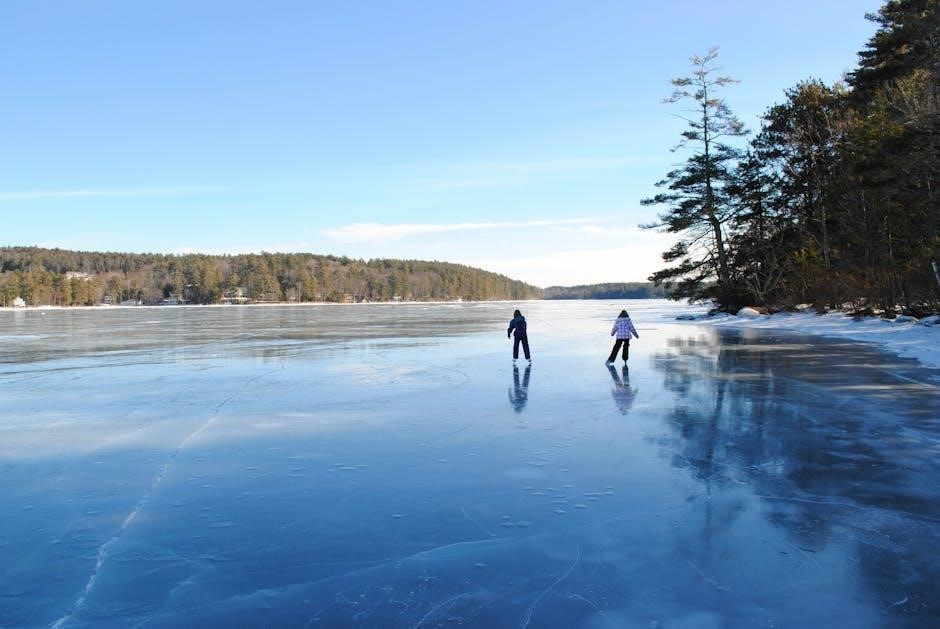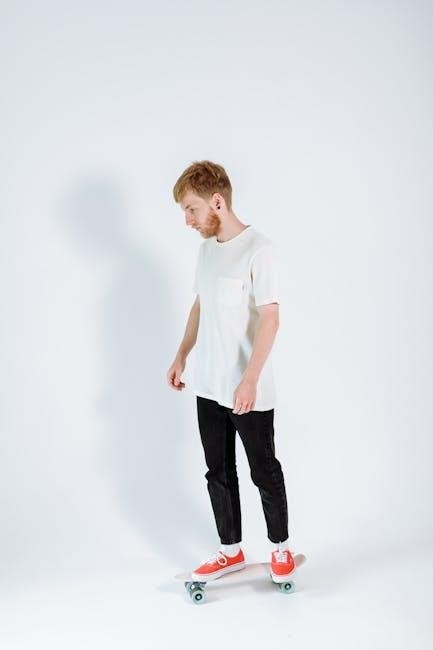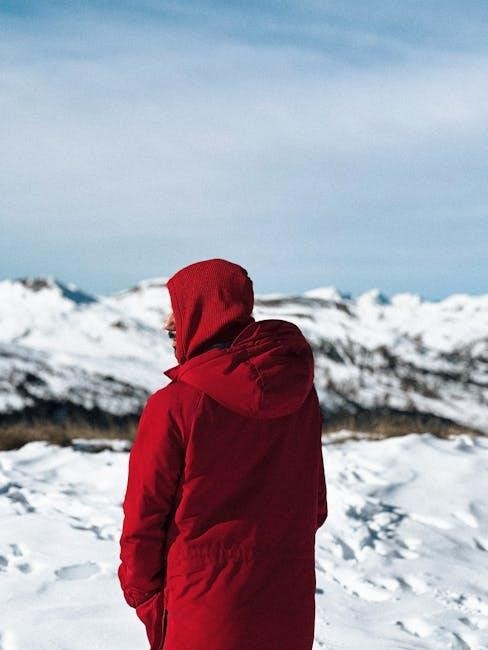Discover how to choose the perfect skating skis with our guide, covering key factors like height, weight, and skiing style for optimal performance and comfort.

Understanding Key Factors Influencing Ski Length
Understanding ski length starts with key factors: height, weight, ability level, skiing style, terrain, and personal preference. These elements ensure optimal performance and comfort on the snow.
1.1 Height and Weight as Primary Determinants
Height and weight are critical in determining the ideal ski length, as they directly impact stability and control. Taller or heavier skiers typically require longer skis for better floatation and balance, while shorter or lighter individuals may prefer shorter skis for easier maneuverability. However, these factors must be balanced with ability level and skiing style. For instance, a skilled skier may opt for a shorter ski for agility, even if their height suggests a longer length. Ultimately, height and weight provide a foundational starting point, which is then refined by other personal and environmental considerations.
1.2 Ability Level and Skiing Style
Your skiing ability and style significantly influence ski length selection. Beginners often benefit from shorter skis, which are easier to control and maneuver, while advanced skiers may prefer longer skis for higher speeds and stability. Racing skis, for instance, are typically longer and stiffer to enhance precision and glide. Recreational skiers might opt for shorter, more forgiving skis for casual outings. Additionally, aggressive skiers who prioritize speed and performance may choose longer skis, whereas those who prefer a more relaxed, easy-going style might lean toward shorter lengths. Flex options also play a role in accommodating different skiing techniques and preferences.
1.3 Terrain and Snow Conditions
Terrain and snow conditions are crucial factors in determining the ideal ski length. On groomed trails, shorter skis provide easier control and agility, making them ideal for quick turns and technique-focused skiing. In deep or ungroomed snow, longer skis float better and maintain momentum, reducing effort. Hard snow requires stiffer skis for stability, while softer snow may prefer slightly shorter lengths for easier handling. Racing skis are optimized for firm conditions, while backcountry skis are longer for navigating varied terrain. Matching ski length to snow conditions ensures optimal performance and a more enjoyable skiing experience.
1.4 Personal Preference and Comfort
Personal preference and comfort play a significant role in selecting ski length. Some skiers prefer longer skis for stability and glide, while others opt for shorter lengths for easier maneuverability. Comfort is key, as skis that feel too long or short can hinder performance. Test skiing different lengths during demo days helps identify the most comfortable fit. Additionally, skiers with a relaxed style may prefer slightly shorter skis, whereas aggressive skiers might favor longer ones. Balancing personal comfort with technical requirements ensures a enjoyable and effective skiing experience tailored to individual needs and skiing habits.

Using Online Size Charts and Manufacturer Guidelines
Consult online size charts and manufacturer guidelines to determine the ideal ski length and stiffness for your needs, ensuring a perfect fit and optimal performance.
2.1 How to Interpret Size Charts
Interpreting size charts for skating skis involves matching your height, weight, and skiing style with recommended lengths. Charts often list ranges, so consider your ability level and terrain preferences. Stiffness options may vary by length, with higher-end skis offering more flexibility. Online tools can help refine your choice, ensuring a balance between performance and comfort. Always cross-reference multiple sources to confirm the best fit for your needs.
2.2 Importance of Stiffness and Flex Options
Stiffness and flex are crucial for optimizing ski performance. Stiffer skis provide better stability at high speeds and edge hold on firm snow, ideal for aggressive skiers. Softer flex suits lighter skiers or those prioritizing ease of turning. Higher-end models often offer multiple stiffness options within the same length, catering to different skier weights and preferences. Proper stiffness ensures efficient energy transfer and control, enhancing overall skiing experience. Always consult size charts or manufacturer guidelines to match stiffness with your weight and skiing style for the best fit.

Trying Before Buying: Demo Days and Test Events
Demo days allow skiers to test equipment on snow, ensuring the perfect fit and performance. Check local event calendars for opportunities to try skis firsthand.
3.1 Locating Demo Days Near You
Finding demo days is easier than ever. Check local ski resort websites, event calendars, and social media for upcoming events. Many manufacturers also list demo tours online. Contact local ski shops for recommendations and dates. These events are a fantastic way to test skis in real conditions, ensuring the best fit and performance for your skiing style and preferences. Don’t miss the opportunity to experience different models before making a purchase. Plan ahead and mark your calendar to attend these valuable test sessions.
3.2 What to Expect During a Demo Day
At a demo day, you’ll have the opportunity to test various ski models in real-world conditions. Bring your ski gear and a valid ID, as some events may require a deposit. Expect friendly staff and experts to guide you through the process, offering tips and advice. Skis are usually pre-waxed and ready to use, allowing you to focus on performance and comfort. Take your time to compare different models, as there’s no pressure to purchase. This hands-on experience is invaluable for making an informed decision. Make the most of this event to find your perfect pair of skis!

How to Choose the Right Skis for Your Needs
Select skis that match your skiing style, terrain preferences, and ability level for optimal performance and comfort on the slopes.
4.1 Race Skis vs. Recreational Skis
Race skis are designed for speed and performance, typically stiffer and longer, while recreational skis prioritize comfort and ease of use, offering more flexibility for casual skiers.
4.2 Backcountry vs. Track Skis
Backcountry skis are designed for off-trail adventures, featuring wider profiles and more rocker for better float in deep snow, while track skis are narrower, lighter, and optimized for groomed trails. Backcountry skis prioritize durability and versatility, often with longer lengths for stability in varied terrain, whereas track skis focus on speed and efficiency on packed snow. The choice between them depends on your skiing environment, with backcountry skis suited for exploring ungroomed areas and track skis excelling on well-maintained paths.
4.3 Length Recommendations for Different Ski Types
For race skis, lengths typically range from 170cm to 210cm, depending on skating style and ability. Recreational skis are shorter, around 160cm to 190cm, for easier handling. Backcountry skis are longer, often between 180cm and 220cm, to provide stability in deep snow. Track skis, designed for groomed trails, usually fall between 150cm and 200cm, balancing speed and maneuverability. Ultimately, ski length should align with your skiing style, terrain, and personal comfort to ensure optimal performance and enjoyment on the snow.

Calculating Ski Length Based on Body Weight and Height
Body weight and height guide ski length, with taller, heavier skiers needing longer skis for stability and shorter, lighter skiers opting for easier maneuverability on snow.
5.1 General Guidelines for Weight and Height
Height and weight are primary factors in determining ski length, with taller, heavier skiers typically requiring longer skis for stability. As a general rule, skiers’ height correlates directly with ski length, ensuring proper glide and control. Weight influences stiffness, as heavier skiers may need stiffer skis for optimal performance. These guidelines serve as a starting point, but individual preferences and skiing styles can adjust the ideal length. Online charts often provide a baseline, but demoing skis is recommended for the best fit. Balancing these factors ensures a harmonious match between skier and equipment for enhanced skiing experiences.
5.2 Adjusting for Skill Level and Terrain
Skill level and terrain significantly influence ski length adjustments. Advanced skiers may prefer shorter skis for agility, while beginners benefit from slightly longer skis for stability. For backcountry or deep snow, longer skis improve floatation, while shorter skis excel on groomed tracks. Skiers tackling varied terrain may opt for mid-length skis to balance performance. Consulting size charts and testing skis ensures the best fit, as personal preference and skiing style also play roles. Tailoring ski length to these factors enhances control, comfort, and overall skiing enjoyment, making every outing more efficient and enjoyable. Proper adjustments ensure optimal performance across diverse conditions and skills. Always test before finalizing.

Maintenance and Care for Optimal Ski Performance
Regular waxing and edge sharpening maintain glide and performance. Store skis in a dry place to prevent rust and damage, ensuring longevity and top condition.
6.1 Waxing and Edging Tips
Regular waxing ensures smooth glide and protects skis from drying out. Apply wax suitable for temperature conditions, typically every 3-5 uses. Use a waxing iron and let cool before scraping.
Sharpen edges periodically for better control and grip on snow. Start with base edge sharpening, then side edges, using diamond stones or files.
Always clean skis after use to remove dirt and moisture. Store in a dry place to prevent rust and maintain performance.
6.2 Storing Skis Properly
Store skis in a cool, dry place to prevent rust and damage. Avoid basements or attics prone to moisture. Clean skis thoroughly before storage,
removing dirt and wax. Dry edges to prevent rust. Store skis upright or hanging to save space, never lying flat, to avoid warping.
Use a ski bag for protection from dust. Avoid exposing skis to extreme temperatures or direct sunlight. Proper storage ensures optimal performance.
Regular maintenance during off-season helps extend ski life and readiness for the next season.

